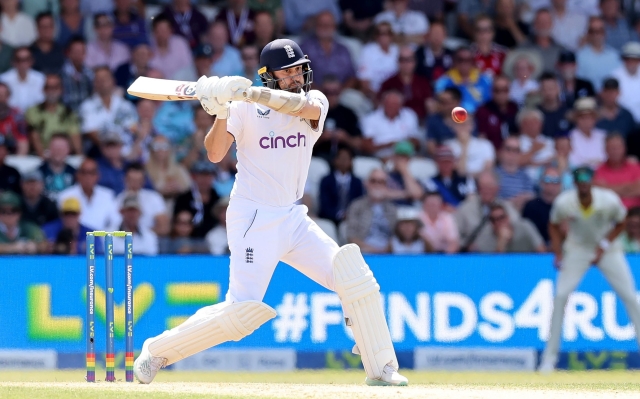 Captains Ben Stokes (left) and Pat Cummins led their teams in the closest ever five test series. AP/Kirsty Wigglesworth
Captains Ben Stokes (left) and Pat Cummins led their teams in the closest ever five test series. AP/Kirsty Wigglesworth
It wasn't the Ashes' best series, because the main problem was solved in the fourth Test by a drizzle in Manchester. We have lost the culmination of the Oval in 2005, as well as in 1953 and 1926, when England overcame all the devastating effects of the world war to regain the urn.
However, it was a subtle difference, the best test series overall against Australia England had ever seen, being the closest, shortest (45 days), most entertaining, fastest (at least when England batted) and the most exciting. Lord's first test in 2005 was not close; these two post-war triumphs came at the end of a rain-scarred streak that ended 1-0.
With the exception of tests at Old Trafford, tests this summer were all on a knife edge: the balance was broken by a single wicket then a quick strike like 24 Mark Wood with eight balls at Headingley. Never has a series of five tests been so close in results. Australia won by two wickets and 43 runs, England by three wickets and 49 runs.
 Mark Wood knocks 24 runs out of eight deliveries at Headingley to get England back in the game. Photo: Getty Images/Jan Kruger
Mark Wood knocks 24 runs out of eight deliveries at Headingley to get England back in the game. Photo: Getty Images/Jan Kruger
So the closest comparison, like the Ashes series, which was interesting from the first ball to the last, would have to be 1972, which also ended 2-2, but in this case, England kept the Ashes, which they won in Australia. This summer, the roles almost reversed. An aging and wary England under Ray Illingworth (M. J. K. Smith came out of retirement to strike) mirrored Australia this summer, while Australia under Ian Chappell and led by Dennis Lilly were young and energetic as a team Ben Stokes.
It was also, in some ways, the most egalitarian Ashes series that no one dominated. No batsman has hit 500 runs or ruled like Steve Smith in the 2019 series; no bowler has taken 25 wickets or ruled like Mitchell Johnson in 2013-14. Both sides used 14 players and all of them had screenings, short periods or opportunities. Even the spin played its part, despite injuries to Jack Leach and Nathan Lyon — England took 15 wickets with the spin, Australia 18 — although it was just off the spin.
For a sporting event that began in 1877 and caught fire when a veil or bail was burned in honor of the England captain on Christmas Eve 1882, it is amazing that it does not age or atrophy; the Ashes series just keeps growing and growing in the mind and imagination. While Australia keeps this useless but priceless urn, every tired player can be proud of their participation.
Part of the lingering appeal is that, over the decades, national idiosyncrasies have not disappeared. It may be sentimental, but when Johnny Bairstow at Old Trafford fired on the Aussies, baggy green caps scattered around the perimeter, they held their line, man by man, and did not flinch.
 Johnny Bairstow kicks 99 balls outside of Old Trafford to silence his critics. Photo: PA/Mike Egerton
Johnny Bairstow kicks 99 balls outside of Old Trafford to silence his critics. Photo: PA/Mike Egerton
The characteristics of English cricketers over the centuries have been demonstrated by their player from the series. When Chris Wakes launched his revolutionary spell in the series' sunny finale, the crowd on the old gas meter side of the Oval roared at him all the way to his position on the field. The match and unfair 3-1 series was a game-changer for Australia, with Steve Smith and Travis Head only needing 120 runs. Wookes answered the applause for Head's gate by raising his left hand, but only to chest level.
As Wakes took the second wicket, Smith's, which essentially won the game for England, he removed his cap with his left hand and raised his right in appreciation, but not above the waist. It was Sir Jack Hobbs taking his leave at the Oval in 1930, or Sir Alastair Cooke retiring in 2018, the height of English self-deprecation. but this is natural for him, as for a great orchestrator. He was always going to crash into the last gate or two. He is one of the few cricketers who can look back without regret to the completion of his journey and the joy of retirement.
 Wide-eyed Stuart Broad took the opportunity to take the last two wickets of the series. Credit: AP/Kirsty Wigglesworth
Wide-eyed Stuart Broad took the opportunity to take the last two wickets of the series. Credit: AP/Kirsty Wigglesworth
This show had something for everyone, Englishman, Australian or onlooker, because everyone had their own opinion on how Alex Carey stumped Barstow in Lord. (To the veteran Pakistani journalist who was present at the end, I perhaps naively advised him to call for a series of five tests between India and Pakistan, so that it could be played anywhere and anywhere to begin the process of government convergence.)
Not even 10 minutes after Brod took the last wicket and the final score was determined, the stumps were removed and only one player remained on the court. The oval gardener swept the dust out of the folds at each end and poured it into a bucket. He may not have known that the original urn contained dust. Doesn't matter. This competition of all cricket competitions, only intensified this summer, continues.























































Свежие комментарии